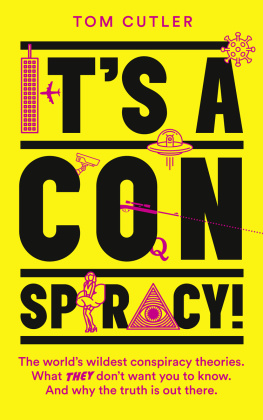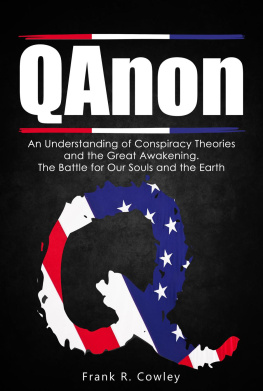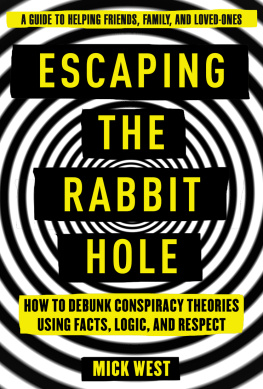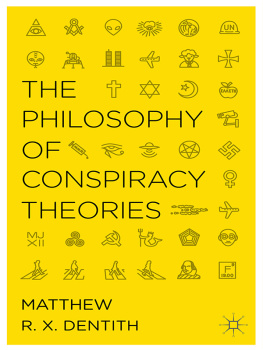HarperCollinsPublishers
1 London Bridge Street
London SE1 9GF
www.harpercollins.co.uk
HarperCollinsPublishers
1st Floor, Watermarque Building, Ringsend Road
Dublin 4, Ireland
First published by HarperCollinsPublishers 2021
FIRST EDITION
Tom Cutler 2021
Cover design by Sim Greenaway HarperCollinsPublishers 2021
Cover illustrations Shutterstock.com
A catalogue record of this book is available from the British Library
Tom Cutler asserts the moral right to be identified as the author of this work
All rights reserved under International and Pan-American Copyright Conventions. By payment of the required fees, you have been granted the nonexclusive, non-transferable right to access and read the text of this e-book on screen. No part of this text may be reproduced, transmitted, downloaded, decompiled, reverse engineered, or stored in or introduced into any information storage retrieval system, in any form or by any means, whether electronic or mechanical, now known or hereinafter invented, without the express written permission of HarperCollins e-books.
Find out about HarperCollins and the environment at
www.harpercollins.co.uk/green
Source ISBN: 9780008440534
Ebook Edition September 2021 ISBN: 9780008440541
Version: 2021-07-14
This ebook contains the following accessibility features which, if supported by your device, can be accessed via your ereader/accessibility settings:
- Change of font size and line height
- Change of background and font colours
- Change of font
- Change justification
- Text to speech
- Page numbers taken from the following print edition: ISBN 9780008440534
To the memory of
William of Ockham
People almost invariably arrive at their beliefs not on the basis of proof but on the basis of what they find attractive.
BLAISE PASCAL
Just because youre paranoid doesnt mean theyre not out to get you.
ANON
We all love a good conspiracy theory, dont we! In this age of science, and more than three hundred years since the Enlightenment, polls show that half of American adults believe at least one conspiracy theory, while more than three-quarters believe in angels. A conspiracy theory is not only the belief that one person is conspiring with another, it also takes in the idea that some shadowy and powerful organisation is involved in skulduggery that is harming ordinary people. I believe all conspiracy theories except the ones that arent true. And theres the problem: sorting the true from the false.
In the fourteenth century, a Franciscan friar named William of Ockham (or Occam) popularised a nifty rule, now known as Occams razor, which he said was useful when you were trying to find out what was true. His idea was that, in general, the simplest of competing theories is probably the right one. Five hundred years later Occams razor is still handy though not always. Sometimes, just to confuse everybody, the correct answer is the more elaborate one as with, say, the Watergate conspiracy (see ).
So, what is it that drives all of us a bit, and some of us a lot, to accept these ideas? In normal life we tend to believe things based on the evidence. If a friend tells us its raining, we will probably look out of the window to check for ourselves. But if she says shes heard that the Moon landings were faked, or that vaccines are dangerous, we are more likely to take her word for it.
We seem to be naturally amenable to these stories, and today, beset as we are by rapid change, worrying complexity, global disease threats and troubling concerns about the quality and competence of our political leaders, conspiracy theories make a brilliant labour-saving tool.
Viren Swami, professor of social psychology at Anglia Ruskin University, says that conspiratorial thinking surges during such periods of societal crisis, when, yearning for meaning and control in their lives, people tend to believe that dark forces are shaping events in an endless battle between good and evil.
For many, politics is no longer a matter of Right and Left; instead its Us against Them. This leads authoritarian right-wingers to cuddle up with probiotic lefties in claims that an apocalyptic Brave New World Order is coming or that Paul McCartney is a clone. So many people have fallen down conspiracy-theory rabbit holes that the BBC now employs a specialist disinformation reporter.
Believing that the Earth is hollow or that Paul McCartney died years ago is pretty harmless. The trouble starts when conspiracy theories go from harmless fun to funless harm. The online movement QAnon, which sprang out of the notorious Pizzagate conspiracy theory in 2016 (see ), has been characterised as a threat by social media platforms and the FBI. Its basic claim when it began was that President Donald Trump was fighting a secret war against a deep state cabal of satanic paedophiles that included Democrats, billionaires and Hollywood celebrities. The superspreading of such patently fishy conspiracy theories by and among QAnons apostles has nonetheless given these followers a profound sense of purpose, power and belonging.
In the end, of course, all conspiracy theories are intriguing, and the best compelling, which may be why so many have lasted so long. Like the old wives tales of yesteryear, some are very probably true, others only possibly true, and a final few have turned out to be pure moonshine, though no less enjoyable for that.
In this book I take a meander through a variety of the most beguiling, from the UK, Europe and the USA a country offering a seam especially rich in conspiracy gold. Theres a conspiracy theory here for every taste, and what better diversion from the grim reality of the twenty-four-hour news cycle than jumping into a world run by a secret society of Lizard Men from outer space, where Finland is fake and Elvis is still with us, running his rhinestone flares through the rinse cycle down at the Memphis laundromat?
Some of these conspiracy theories, and theorists, will make you laugh, others will make you think, and with at least one Hey, Martha! moment per page, showcasing some especially curious and sparkling nugget, youll find yourself frequently elbowing your partner in the ribs.
But, before you begin, heres a bit of advice. Try to dodge the temptation to start in the foothills of page one and then hike non-stop to the very top of the mountain, as you would with Madame Bovary. Instead, treat this more like a sauna: nip in quick somewhere, thrash yourself with a few twigs and get out sharpish for a splash in the cold pond. Later you can have another go, on a different page. By taking it in short bursts, I hope you will be able to detach yourself pleasantly from the cares of the world without getting all hot and bothered.
Anyway, without further ado, it is now time to put on your tinfoil hat, take a deep lungful of air and launch yourself boldly out into the wild unknown of Conspiracyland
I
Assassination Conspiracies
A wise man proportions his belief to the evidence.
DAVID HUME
Shortly after midnight on the morning of 31 August 1997, thirty-six-year-old Diana, Princess of Wales, and her suitor Dodi Fayed were about to leave the Ritz Hotel in Paris to travel to a nearby flat both properties owned by Dodis fantastically rich father. Outside the building on Place Vendme, thirty or so paparazzi were waiting, itching to get a snap of the glamorous couple. In an effort to dodge these charming gentlemen, a cunning plan had been devised. A decoy vehicle would be standing by, which, on a signal, would leave the Ritz from the main entrance. Diana and Dodi would then quietly depart from the hotels back door to be driven to their flat in a black Mercedes-Benz by the Ritzs deputy head of security, Henri Paul.













